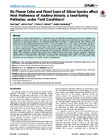Do Flower Color and Floral Scent of Silene Species affect Host Preference of Hadena bicruris, a Seed-Eating Pollinator, under Field Conditions?
dc.contributor.author
Schiestl, Florian P.
dc.contributor.author
Karrenberg, Sophie
dc.contributor.author
Page, Paul A.
dc.contributor.author
Favre, Adrien
dc.date.accessioned
2022-02-03T16:39:45Z
dc.date.available
2017-06-11T10:40:18Z
dc.date.available
2018-09-27T09:20:54Z
dc.date.available
2022-02-03T16:39:45Z
dc.date.issued
2014-06-06
dc.identifier.issn
1932-6203
dc.identifier.other
10.1371/journal.pone.0098755
en_US
dc.identifier.uri
http://hdl.handle.net/20.500.11850/86434
dc.identifier.doi
10.3929/ethz-b-000086434
dc.description.abstract
Specialization in plant–insect interactions is an important driver of evolutionary divergence; yet, plant traits mediating such interactions are poorly understood. In this study, we investigated how flower color and floral scent are related to seed predation by a seed-eating pollinator. We used field-transplanted recombinant F2 hybrids between Silene latifolia and S. dioica that are the preferred and alternative hosts of the moth Hadena bicruris and crosses within these species for comparison. We scored seed predation and flower color and analyzed floral scent. Pinker S. dioica-like flowers and emission of α-pinene decreased the odds of seed predation while emission of benzyl acetate and 6-methyl-5-hepten-2-one increased the odds of seed predation. Emission of these compounds did not differ significantly between the two Silene species. Our results suggest that flower color plays an important role in the specific interaction of H. bicruris with its preferred host S. latifolia. The compounds α-pinene, benzyl acetate and 6-methyl-5-hepten-2-one could represent non-specific deterrents and attractants to ovipositing moths. Alternatively, emission of these compounds could be related to herbivory or pathogen attack and act as a signal for host quality. This would weaken the predictability of the plant's costs and benefits of the interaction and act to maintain an imperfect degree of specialization.
en_US
dc.format
application/pdf
en_US
dc.language.iso
en
en_US
dc.publisher
PLOS
dc.rights.uri
http://creativecommons.org/licenses/by/4.0/
dc.title
Do Flower Color and Floral Scent of Silene Species affect Host Preference of Hadena bicruris, a Seed-Eating Pollinator, under Field Conditions?
en_US
dc.type
Journal Article
dc.rights.license
Creative Commons Attribution 4.0 International
ethz.journal.title
PLoS ONE
ethz.journal.volume
9
en_US
ethz.journal.issue
6
en_US
ethz.journal.abbreviated
PLoS ONE
ethz.pages.start
e98755
en_US
ethz.size
9 p.
en_US
ethz.version.deposit
publishedVersion
en_US
ethz.identifier.wos
ethz.identifier.scopus
ethz.publication.place
San Francisco, CA
ethz.publication.status
published
en_US
ethz.date.deposited
2017-06-11T10:42:28Z
ethz.source
ECIT
ethz.identifier.importid
imp5936521426de425367
ethz.ecitpid
pub:136055
ethz.eth
yes
en_US
ethz.availability
Open access
en_US
ethz.rosetta.installDate
2017-07-12T23:28:26Z
ethz.rosetta.lastUpdated
2024-02-02T16:16:05Z
ethz.rosetta.versionExported
true
ethz.COinS
ctx_ver=Z39.88-2004&rft_val_fmt=info:ofi/fmt:kev:mtx:journal&rft.atitle=Do%20Flower%20Color%20and%20Floral%20Scent%20of%20Silene%20Species%20affect%20Host%20Preference%20of%20Hadena%20bicruris,%20a%20Seed-Eating%20Pollinator,%20under%20Field&rft.jtitle=PLoS%20ONE&rft.date=2014-06-06&rft.volume=9&rft.issue=6&rft.spage=e98755&rft.issn=1932-6203&rft.au=Schiestl,%20Florian%20P.&Karrenberg,%20Sophie&Page,%20Paul%20A.&Favre,%20Adrien&rft.genre=article&rft_id=info:doi/10.1371/journal.pone.0098755&
Dateien zu diesem Eintrag
Publikationstyp
-
Journal Article [128876]

